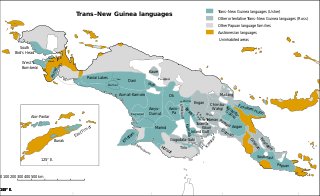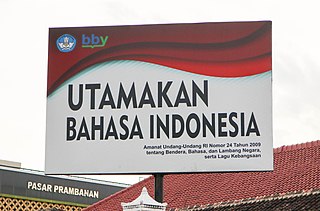Related Research Articles

Trans–New Guinea (TNG) is an extensive family of Papuan languages spoken on the island of New Guinea and neighboring islands, a region corresponding to the country Papua New Guinea as well as parts of Indonesia.

In addition to its classical and modern literary form, Malay had various regional dialects established after the rise of the Srivijaya empire in Sumatra, Indonesia. Also, Malay spread through interethnic contact and trade across the south East Asia Archipelago as far as the Philippines. That contact resulted in a lingua franca that was called Bazaar Malay or low Malay and in Malay Melayu Pasar. It is generally believed that Bazaar Malay was a pidgin, influenced by contact among Malay, Hokkien, Portuguese, and Dutch traders.
The Foja Range languages, or Tor–Kwerba in more limited scope, are a family of about two dozen Papuan languages. They are named after the Foja Mountains of western New Guinea.
Isirawa is a Papuan language spoken by about two thousand people on the north coast of Papua province, Indonesia. It's a local trade language, and use is vigorous. Stephen Wurm (1975) linked it to the Kwerba languages within the Trans–New Guinea family, and it does share about 20% of its vocabulary with neighboring Kwerba languages. However, based on its pronouns, Malcolm Ross (2005) felt he could not substantiate such a link, and left it as a language isolate. The pronouns are not, however, dissimilar from those of Orya–Tor, which Ross links to Kwerba, and Donahue (2002) accept it as a Greater Kwerba language.
The Burmeso language – also known as Taurap – is spoken by some 300 people in Burmeso village along the mid Mamberamo River in Mamberamo Tengah subdistrict, Mamberamo Raya Regency, Papua province, Indonesia. It is surrounded by the Kwerba languages to the north, the Lakes Plain languages to the south, and the East Cenderawasih Bay languages to the west.
Warembori is a moribund language spoken by about 600 people in Warembori village, Mamberamo Hilir District, Mamberamo Raya Regency, located around river mouths on the north coast of Papua, Indonesia.

Indonesia is home to over 700 living languages, creoles, and dialects spoken across its extensive archipelago. This significant linguistic variety constitutes approximately 10% of the world’s total languages, positioning Indonesia as the second most linguistically diverse nation globally, following Papua New Guinea. The majority of these languages belong to the Austronesian language family, prevalent in the western and central regions of Indonesia, including languages such as Acehnese, Sundanese, and Buginese. In contrast, the eastern regions, particularly Papua and the Maluku Islands, are home to over 270 Papuan languages, which are distinct from the Austronesian family and represent a unique linguistic heritage. The language most widely spoken as a native language is Javanese, primarily by the Javanese people in the central and eastern parts of Java Island, as well as across many other islands due to migration.
The half dozen Kwerba languages form a small language family spoken in Jayapura Regency of Indonesian West Papua.
Massep is a poorly documented Papuan language spoken by fewer than 50 people in the single village of Masep in West Pantai District, Sarmi Regency, Papua. Despite the small number of speakers, however, language use is vigorous. It is surrounded by the Kwerba languages Airoran and Samarokena.
The Orya–Tor languages are a family of just over a dozen Papuan languages spoken in Western New Guinea, Indonesia.
Demta, also known as Sowari and Muris, is a Papuan language on the north coast of Papua, Indonesia. It is spoken in Ambora, Muris Besar, Muris Kecil, and Yougafsa villages, all located in Demta District.
Kwerba is a Papuan language of Indonesia. Alternate names are Airmati (Armati), Koassa, Mataweja, Naibedj, Segar Tor, Tekutameso.
Tabla is spoken on the coast of Tanahmerah Bay, close to Jayapura, in northern Papua (Indonesia). It is spoken in Bukia, Depapre, and Wari towns, and 13 villages on north coast. Dialects are Yokari, Tepera, and Yewena-Yongsu.
Mekwei (Menggwei), or Mooi, is a Papuan language of Jayapura Regency, Papua, Indonesia. It is spoken in Kendate, Maribu, Sabron Dosay, and Waibrong villages.
Mandobo, or Kaeti, is a Papuan language of Mandobo District in Boven Digoel Regency, South Papua, Indonesia.
Muyu, Moyu, is one of the Ok languages of South Papua, Indonesia.
Auye (Auwje) and Dao are the two dialects of a Papuan language spoken in the Paniai lakes region of the Indonesian province of Papua. The Moi dialect has been called 'Dao' after a neighboring river.
Woria is a nearly extinct Papuan language of the Indonesian province of Papua, on the eastern shore of Cenderawasih Bay. It is spoken in Botawa village, Waropen Regency, where the Lakes Plain language Saponi was also spoken.
Kwerba Mamberamo is a Papuan language of Indonesia.
Jofotek-Bromnya is a Papuan language of Sarmi Regency, Papua, Indonesia.
References
- ↑ Samarokena at Ethnologue (18th ed., 2015) (subscription required)
- ↑ Eberhard, David M.; Simons, Gary F.; Fennig, Charles D., eds. (2019). "Indonesia languages". Ethnologue: Languages of the World (22nd ed.). Dallas: SIL International.